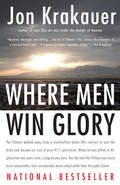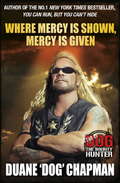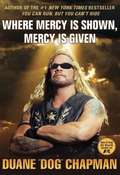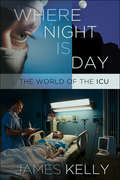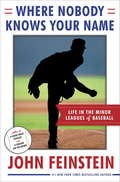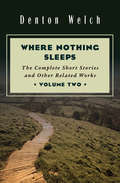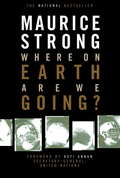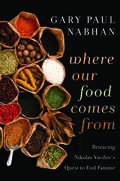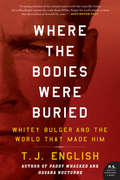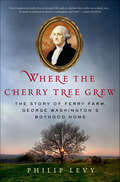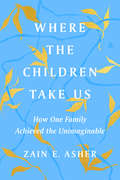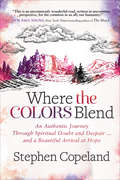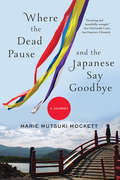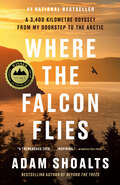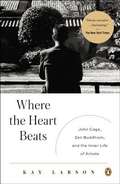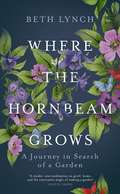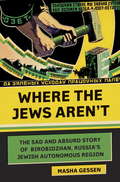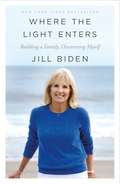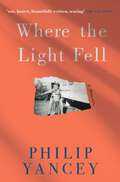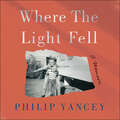- Table View
- List View
Where Men Win Glory: The Odyssey of Pat Tillman
by Jon KrakauerThis edition has been updated to reflect new developments and includes new material obtained through the Freedom of Information Act. Pat Tillman walked away from a multimillion-dollar NFL contract to join the Army and became an icon of post-9/11 patriotism. When he was killed in Afghanistan two years later, a legend was born. But the real Pat Tillman was much more remarkable, and considerably more complicated than the public knew. A stunning account of a remarkable young man's heroic life and death, from the bestselling author of Into the Wild, Into Thin Air, and Under the Banner of Heaven.From the Trade Paperback edition.
Where Mercy is Shown, Mercy is Given: Star of Dog the Bounty Hunter
by Duane ChapmanIn Dog We Trust. More tales from the world's most famous bounty hunter.'This is your wake up call. You either answer it now, or pay for it for the rest of your life. The choice is yours.'Duane 'Dog' Chapman is the world's most famous bounty hunter. During his hard-hitting and often controversial career, he has rounded up more than 6,000 criminals, and inspired and entertained millions on his top-rated TV show, DOG THE BOUNTY HUNTER. But his job doesn't end when the cuffs go on...Having been on the wrong side of the law himself - abuse, addiction, crime, gangs, prison - and turned his life around to become an American icon, Dog knows how to get fugitives back on the straight and narrow. And he makes it his business to help.This is an action-packed account of life on the front line, bringing dangerous criminals to justice. It is also the incredible story of a man who has struggled with his own flaws and made the transition from hell-raiser to peacekeeper.
Where Mercy Is Shown, Mercy Is Given
by Laura Morton Duane Dog ChapmanThe incredible story of struggle, redemption, and bounty hunting--which has catapulted Duane "Dog" Chapman into the hearts of millions, sparked a #1 rated television show, and inspired a #1 New York Times bestselling book--continues in Where Mercy Is Shown, Mercy Is Given."Who is going to give them the ride, Duane? Who will give them the cigarette and who will give them 'the talk'?"When the preacher posed those questions to me, I realized he was right. If not me, then who? Whether I had planned it or not, I was leading a backseat ministry, one ride at a time.--from Where Mercy Is Shown, Mercy Is GivenConsidered by many to be the world's greatest bounty hunter, Duane "Dog" Chapman has become famous for capturing fugitives on Dog the Bounty Hunter, his #1 rated show on A&E.But his job doesn't end when he cuffs his man--or woman.Having personally struggled against abuse, addition, and a life of crime, Dog knows a thing or two about the path that these fugitives cuffed in the back of his car are on--and he has a good idea of the bad news they'll find at the end of it. As someone who has succeeded in beating the odds and finding a way to live on the right side of the law, Dog also knows what the person in the backseat needs to hear in order to straighten out his or her life."This is your wake up call. You either answer it now, or pay for it later and for the rest of your life. You're being given another shot at things, but only if you take the risk to make the right decision. The choice is yours. What's it going to be, brotha?"While he is himself a mentor to many, Dog draws strength from the great teachers in his own life to face the surprising and difficult challenges that have come his way. Through hard work, unflinching faith, and the acknowledgment of his own flaws--along with the overwhelming desire to fix those flaws--Dog has been through the fire again and again, and come out the stronger for it.Revealing, behind-the-scenes looks at Dog's most significant challenges, along with seat-of-your-pants accounts of his most breakneck bounty hunting stories, makes Where Mercy Is Shown, Mercy Is Given a must-read for any fan.
Where Night Is Day: The World of the ICU (The Culture and Politics of Health Care Work)
by James Kelly"There is no night in the ICU. There is day, lesser day, then day again. There are rhythms. Every twelve hours: shift change. Report: first all together in the big room, then at the bedside, nurse to nurse. Morning rounds. A group of doctors moves slowly through the unit like a harrow through a field. At each room, like a game, a different one rotates into the center. They leave behind a trail of new orders. Wean, extubate, titrate, start this, stop that, scan, film, scope. The steep hill the patient is asked to climb. Can you breathe on your own? Can you wake up? Can you live?"-from Where Night Is DayWhere Night Is Day is a nonfiction narrative grounded in the day-by-day, hour-by-hour rhythms of an ICU in a teaching hospital in the heart of New Mexico. It takes place over a thirteen-week period, the time of the average rotation of residents through the ICU. It begins in September and ends at Christmas. It is the story of patients and families, suddenly faced with critical illness, who find themselves in the ICU. It describes how they navigate through it and find their way. James Kelly is a sensitive witness to the quiet courage and resourcefulness of ordinary people. Kelly leads the reader into a parallel world: the world of illness. This world, invisible but not hidden, not articulated by but known by the ill, does not readily offer itself to our understanding. In this context, Kelly reflects on the nature of medicine and nursing, on how doctors and nurses see themselves and how they see each other. Drawing on the words of medical historians, doctor-writers, and nursing scholars, as well as the works of James Agee and Michel de Certeau, Kelly examines the relationship of professional and lay observers to the meaning of illness, empathy, caring, and the silence of suffering. As Kelly reflects on the rise of medicine, the theory of nursing, the argument of care versus cure, he offers up an intimate portrait of the ICU and its inhabitants.
Where Nobody Knows Your Name: Life In the Minor Leagues of Baseball (Anchor Sports Ser.)
by John FeinsteinFrom the acclaimed #1 bestselling author . . . a riveting journey through the world of minor-league baseball&“No one grows up playing baseball pretending that they&’re pitching or hitting in Triple-A.&” —Chris Schwinden, Triple-A pitcher&“If you don&’t like it here, do a better job.&” —Ron Johnson, Triple-A managerJohn Feinstein gave readers an unprecedented view of the PGA Tour in A Good Walk Spoiled. He opened the door to an NCAA basketball locker room in his explosive bestseller A Season on the Brink. Now, turning his eye to our national pastime, sports journalist John Feinstein explores the colorful and mysterious world of minor-league baseball—a gateway through which all major-league players pass in their careers . . . hoping never to return. Baseball&’s minor leagues are a paradox. For some players, the minors are a glorious launching pad toward years of fame and fortune; for others, a crash-landing pad when injury or poor play forces a big leaguer back to a life of obscure ballparks and cramped buses instead of Fenway Park and plush charter planes. Focusing exclusively on the Triple-A level, one step beneath Major League Baseball, Feinstein introduces readers to nine unique men: three pitchers, three position players, two managers, and an umpire. Through their compelling stories, Feinstein pulls back the veil on a league that is chock-full of gifted baseball players, managers, and umpires who are all one moment away from getting called up—or back—to the majors. The stories are hard to believe: a first-round draft pick and pitching ace who rocketed to major-league success before finding himself suddenly out of the game, hatching a presumptuous plan to get one more shot at the mound; a home run–hitting former World Series hero who lived the dream, then bounced among six teams before facing the prospects of an unceremonious end to his career; a big-league All-Star who, in the span of five months, went from being completely out of baseball to becoming a star in the ALDS, then signing a $10 million contract; and a well-liked designated hitter who toiled for eighteen seasons in the minors—a record he never wanted to set—before facing his final, highly emotional chance for a call-up to the big leagues. From Raleigh to Pawtucket, from Lehigh Valley to Indianapolis and beyond, Where Nobody Knows Your Name gives readers an intimate look at a baseball world not normally seen by the fans. John Feinstein gets to the heart of the human stories in a uniquely compelling way, crafting a masterful book that stands alongside his very best works.
Where Nothing Sleeps Volume One: The Complete Short Stories and Other Related Works (Where Nothing Sleeps #1)
by Denton WelchThe first volume of Denton Welch&’s complete collected short works English novelist Denton Welch originally trained as a visual artist, and a painterly perspicacity and talent for human observation are evident in his writing. His close attention to detail renders even the most seemingly mundane trivialities memorable and important. Though he died at the young age of thirty-three, Welch was quite prolific, doing most of his writing while bedridden after a bicycling accident that left him seriously injured. He produced three novels, over seventy-five short stories, and a journal that ran over two hundred fifty thousand words long. Included in this volume are autobiographical works inspired by Welch&’s youth in China, such as &“I Can Remember&” and &“The Coffin on the Hill.&” &“I First Began to Write&” is a brief vignette detailing Welch&’s early efforts as an author. These stories, fragments, and poems reveal a writer gifted with superb powers of description.
Where Nothing Sleeps Volume Two: The Complete Short Stories and Other Related Works (Where Nothing Sleeps #2)
by Denton WelchThe second volume of Denton Welch&’s complete collected short works English novelist Denton Welch originally trained as a visual artist, and a painterly perspicacity and talent for human observation are evident in his writing. His close attention to detail renders even the most seemingly mundane trivialities memorable and important. Though he died at the young age of thirty-three, Welch was quite prolific, doing most of his writing while bedridden after a bicycling accident that left him seriously injured. He produced three novels, over seventy-five short stories, and a journal that ran over two hundred fifty thousand words long. This volume includes &“Man in a Garden,&” a brief prose piece that recounts the sketching of a friend in a garden, and the poignant &“Memories of a Vanished Period,&” which takes place at a wedding. Also included is a selection of stories that depart somewhat from Welch&’s standard autobiographical style, venturing into the territory of fiction.
Where on Earth Are We Going?
by Maurice StrongA surprising call to action from a key business and environmental player at the dawn of the millenium.From the Report to the Shareholders, Earth Inc., dated January 1, 2030 that begins Where on Earth Are We Going?: world hunger, ecological and environmental disaster, global warming, massive shifts in weather systems, the re-emergence of diseases long thought controlled, and political turmoil in a world where a barrel of water is more expensive than a barrel of oil.Hard-headed, practical, impassioned, this is a call to action by a key business and environmental leader at the end of the twentieth century that cannot be ignored. To explain how he came by his beliefs, Maurice Strong chronicles his poverty-stricken beginnings as a child in the prairies during the Depression to his appointment as President of Power Corporation at 29, his appointment as Undersecretary of the United Nations at 40, and on the domestic front, as Chairman of Ontario Hydro.From the Trade Paperback edition.
Where Our Food Comes From: Retracing Nikolay Vavilov's Quest to End Famine
by Gary Paul NabhanThe future of our food depends on tiny seeds in orchards and fields the world over. In 1943, one of the first to recognize this fact, the great botanist Nikolay Vavilov, lay dying of starvation in a Soviet prison. But in the years before Stalin jailed him as a scapegoat for the country's famines, Vavilov had traveled over five continents, collecting hundreds of thousands of seeds in an effort to outline the ancient centers of agricultural diversity and guard against widespread hunger. Now, another remarkable scientist--and vivid storyteller--has retraced his footsteps. In Where Our Food Comes From, Gary Paul Nabhan weaves together Vavilov's extraordinary story with his own expeditions to Earth's richest agricultural landscapes and the cultures that tend them. Retracing Vavilov's path from Mexico and the Colombian Amazon to the glaciers of the Pamirs in Tajikistan, he draws a vibrant portrait of changes that have occurred since Vavilov's time and why they matter. In his travels, Nabhan shows how climate change, free trade policies, genetic engineering, and loss of traditional knowledge are threatening our food supply. Through discussions with local farmers, visits to local outdoor markets, and comparison of his own observations in eleven countries to those recorded in Vavilov's journals and photos, Nabhan reveals just how much diversity has already been lost. But he also shows what resilient farmers and scientists in many regions are doing to save the remaining living riches of our world. It is a cruel irony that Vavilov, a man who spent his life working to foster nutrition, ultimately died from lack of it. In telling his story, Where Our Food Comes From brings to life the intricate relationships among culture, politics, the land, and the future of the world's food.
Where Rivers Part: A Story of My Mother's Life
by Kao Kalia YangAn Esquire Best Memoir of 2024 A mesmerizing and hauntingly beautiful memoir about a Hmong family&’s epic journey to safety told from the perspective of the author&’s incredible mother who survived, and helped her family escape, against all odds.Born in 1961 in war-torn Laos, Tswb&’s childhood was marked by the violence of America&’s Secret War and the CIA recruitment of the Hmong and other ethnic minorities into the lost cause. By the time Tswb was a teenager, the US had completely vacated Laos, and the country erupted into genocidal attacks on the Hmong people, who were labeled as traitors. Fearing for their lives, Tswb and her family left everything they knew behind and fled their village for the jungle. Perpetually on the run and on the brink of starvation, Tswb eventually crossed paths with the man who would become her future husband. Leaving her own mother behind, she joined his family at a refugee camp, a choice that would haunt her for the rest of her life. Eventually becoming a mother herself, Tswb raised her daughters in a state of constant fear and hunger until they were able to emigrate to the US, where the determined couple enrolled in high school even though they were both nearly thirty, and worked grueling jobs to provide for their children. Now, her daughter, Kao Kalia Yang, reveals her mother&’s astonishing saga with tenderness and unvarnished clarity, giving voice to the countless resilient refugees who are often overlooked as one of the essential foundations of this country. Evocative, stirring, and unforgettable, Where Rivers Part is destined to become a classic.
Where the Ashes Are: The Odyssey of a Vietnamese Family
by Nguyen Qui Du’cIn 1968 Nguyen Qui Duc was nine years old, his father was a high-ranking civil servant in the South Vietnamese government, and his mother was a school principal. Then the Viet Cong launched their Tet offensive, and the Nguyen family’s comfortable life was destroyed. The author’s father was taken prisoner and marched up the Ho Chi Minh Trail. North Vietnam's highest-ranking civilian prisoner, he eventually spent twelve years in captivity, composing poems in his head to maintain his sanity. Nguyen himself escaped from Saigon as North Vietnamese tanks approached in 1975. He came of age as an American teenager, going to school dances and working at a Roy Rogers restaurant, yet yearning for the homeland and parents he had to leave behind. The author’s mother stayed in Vietnam to look after her mentally ill daughter. She endured poverty and “reeducation” until her husband was freed and the Nguyens could reunite. Intertwining these three stories, Where the Ashes Are shows us the Vietnam War through a child’s eyes, privation after a Communist takeover, and the struggle of new immigrants. The author, who returned to Vietnam as an American reporter, provides a detailed portrait of the nation as it opened to the West in the early 1990s. Where the Ashes Are closes with Nguyen’s thoughts on being pulled between his adopted country and his homeland.
Where the Bodies Were Buried: Whitey Bulger and the World That Made Him
by T. J. EnglishThe New York Times bestselling author of The Westies and Paddy Whacked offers a front-row seat at the trial of Whitey Bulger, and an intimate view of the world of organized crime--and law enforcement--that made him the defining Irish American gangster.For sixteen years, Whitey Bulger eluded the long reach of the law. For decades one of the most dangerous men in America, Bulger--the brother of influential Massachusetts senator Billy Bulger--was often romanticized as a Robin Hood-like thief and protector. While he was functioning as the de facto mob boss of New England, Bulger was also serving as a Top Echelon informant for the FBI, covertly feeding local prosecutors information about other mob figures--while using their cover to cleverly eliminate his rivals, reinforce his own power, and protect himself from prosecution. Then, in 2011, he was arrested in southern California and returned to Boston, where he was tried and convicted of racketeering and murder.Our greatest chronicler of the Irish mob in America, T. J. English covered the trial at close range--by day in the courtroom, but also, on nights and weekends, interviewing Bulger's associates as well as lawyers, former federal agents, and even members of the jury in the backyards and barrooms of Whitey's world. In Where the Bodies Were Buried, he offers a startlingly revisionist account of Bulger's story--and of the decades-long culture of collusion between the Feds and the Irish and Italian mob factions that have ruled New England since the 1970s, when a fateful deal left the FBI fatally compromised. English offers an authoritative look at Bulger's own understanding of his relationship with the FBI and his alleged immunity deal, and illuminates how gangsterism, politics, and law enforcement have continued to be intertwined in Boston.As complex, harrowing, and human as a Scorsese film, Where the Bodies Were Buried is the last word on a reign of terror that many feared would never end.
Where the Cherry Tree Grew: The Story of Ferry Farm, George Washington's Boyhood Home
by Philip LevyNoted historian pens biography of Ferry Farm—George Washington's boyhood home—and its three centuries of American historyIn 2002, Philip Levy arrived on the banks of Rappahannock River in Virginia to begin an archeological excavation of Ferry Farm, the eight hundred acre plot of land that George Washington called home from age six until early adulthood. Six years later, Levy and his team announced their remarkable findings to the world: They had found more than Washington family objects like wig curlers, wine bottles and a tea set. They found objects that told deeper stories about family life: a pipe with Masonic markings, a carefully placed set of oyster shells suggesting that someone in the household was practicing folk magic. More importantly, they had identified Washington's home itself—a modest structure in line with lower gentry taste that was neither as grand as some had believed nor as rustic as nineteenth century art depicted it.Levy now tells the farm's story in Where the Cherry Tree Grew. The land, a farmstead before Washington lived there, gave him an education in the fragility of life as death came to Ferry Farm repeatedly. Levy then chronicles the farm's role as a Civil War battleground, the heated later battles over its preservation and, finally, an unsuccessful attempt by Wal-Mart to transform the last vestiges Ferry Farm into a vast shopping plaza.
Where the Children Take Us: How One Family Achieved the Unimaginable
by Zain E. AsherIn this spellbinding memoir, popular CNN anchor Zain E. Asher pays tribute to her mother’s strength and determination to raise four successful children in the shadow of tragedy. Awaiting the return of her husband and young son from a road trip, Obiajulu Ejiofor receives shattering news. There’s been a fatal car crash, and one of them is dead. In Where the Children Take Us, Obiajulu’s daughter, Zain E. Asher, tells the story of her mother’s harrowing fight to raise four children as a widowed immigrant in South London. There is tragedy in this tale, but it is not a tragedy. Drawing on tough-love parenting strategies, Obiajulu teaches her sons and daughters to overcome the daily pressures of poverty, crime and prejudice—and much more. With her relentless support, the children exceed all expectations—becoming a CNN anchor, an Oscar-nominated actor—Asher’s older brother Chiwetel Ejiofor (12 Years a Slave)—a medical doctor, and a thriving entrepreneur. The generations-old Nigerian parenting techniques that lead to the family's salvation were born in the village where young Obiajulu and Arinze meet with their country on the brink of war. Together, they emigrate to London in the 1970s to escape the violence, but soon confront a different set of challenges in the West. When grief threatens to engulf her fractured family after the accident, Obiajulu, suddenly a single mother in a foreign land, refuses to accept defeat. As her children veer down the wrong path, she instills a family book club with Western literary classics, testing their resolve and challenging their deeper understanding. Desperate for inspiration, she plasters newspaper clippings of Black success stories on the walls and hunts for overachieving neighbors to serve as role models, all while running Shakespeare theatre lines with her son and finishing homework into the early morning with Zain. When distractions persist, she literally cuts the TV cord and installs a residential pay phone.The story of a woman who survived genocide, famine, poverty, and crushing grief to rise from war torn Africa to the streets of South London and eventually the drawing rooms of Buckingham Palace, Where the Children Take Us is an unforgettable portrait of strength, tenacity, love, and perseverance embodied in one towering woman.
Where the Colors Blend: An Authentic Journey Through Spiritual Doubt and Despair … and a Beautiful Arrival at Hope
by Stephen CopelandIn Where the Colors Blend, Stephen Copeland&’s self-discovery and God-discovery is told over a period of six years in the context of an annual retreat to the Blue Ridge Mountains in Roanoke, Virginia, where an obscure, forty-year-old church softball tournament takes place each summer to raise funds for mission work in Paraguay. In stepping into these stories, and sharing them with the reader, Stephen simultaneously journeys deeper within himself, discovering the divine in the process and taking readers deep into the throes of doubt, deconstruction, and depression. But it&’s there, in the darkness, that an authentic hope finds him. Throughout the narrative, readers experience with Stephen a number of paradigm shifts in the areas of: Spirituality: from exhausting oneself trying to get close to God to simply abiding: awakening to who we already are at the core of our beings as children of God.Psychology: from suppressing emotions, pains, and insecurities to curiously and non-judgmentally exploring them.Relationships: from trying to change others or silently judging them to accepting others as they are and learning from those who are most different than ourselves: abandoning ignorance and arrogance.Art, writing, and work: from being taunted by internal demands and a relentless pursuit of perfection to simply enjoying the gift of the process. Stephen's present-tense narrative, mysteriously unfolding all the way, is free-thinking and free-flowing, swinging from humor to complex theology, from someone else&’s story to sudden introspectiveness and application, creating a unique experience for readers as it challenges them to adopt their own lifestyle of introspection and contemplation.
Where the Dead Pause, and the Japanese Say Goodbye: A Journey
by Marie Mutsuki MockettHow does one cope with overwhelming grief? Marie Mutsuki Mockett's family owns a Buddhist temple 25 miles from the Fukushima Daiichi nuclear power plant. In March 2011, after the earthquake and tsunami, radiation levels prohibited the burial of her Japanese grandfather's bones. As Japan mourned thousands of people lost in the disaster, Mockett also grieved for her American father, who had died unexpectedly. Seeking consolation, Mockett is guided by a colorful cast of Zen priests and ordinary Japanese who perform rituals that disturb, haunt, and finally uplift her. Her journey leads her into the radiation zone in an intricate white hazmat suit; to Eiheiji, a school for Zen Buddhist monks; on a visit to a Crab Lady and Fuzzy-Headed Priest's temple on Mount Doom; and into the "thick dark" of the subterranean labyrinth under Kiyomizu temple, among other twists and turns. From the ecstasy of a cherry blossom festival in the radiation zone to the ghosts inhabiting chopsticks, Mockett writes of both the earthly and the sublime with extraordinary sensitivity. Her unpretentious and engaging voice makes her the kind of companion a reader wants to stay with wherever she goes, even into the heart of grief itself.
Where the Falcon Flies: A 3,400 Kilometre Odyssey From My Doorstep to the Arctic
by Adam ShoaltsFrom Canada&’s most accomplished adventurer and storyteller comes a gripping journey into the vastness of Canada&’s landscape and history.Looking out his porch window one spring morning, Adam Shoalts spotted a majestic peregrine falcon flying across the neighbouring fields near Lake Erie. Each spring, falcons migrate from southernmost Canada to remote arctic mountains. Grabbing his backpack and canoe, Shoalts resolved to follow the falcon&’s route north on an astonishing 3,400-kilometre journey to the Arctic.Along the way, he faces a huge variety of challenges and obstacles, including storms on the Great Lakes, finding campsites in the urban wilderness of Toronto and Montreal, avoiding busy commercial freighter traffic, gale force winds, massive hydroelectric dams, bushwhacking without trails, dealing with hunger, multiple bear encounters, and navigating white-water rapids on icy northern rivers far from any help.In his signature style, Shoalts roams as much across space as he does time, winding his way through a stunning diversity of landscapes ranging from lush Carolinian forests to lonely windswept mountains, salty seas to trackless swamps, pristine lakes to glittering mega-cities, as well as the sites of long ago battles, shipwrecks, forgotten forts, and abandoned trading posts. Through his travels, he reveals how interconnected wild places are, from the loneliest depths of the northern wilderness to busy urban parks, and the vital importance of these connections.Where the Falcon Flies invites readers on an extraordinary armchair adventure that spans five ecoregions and centuries of fascinating history, and is a masterwork by one of Canada&’s most successful and audacious authors.
Where the Heart Beats: John Cage, Zen Buddhism, and the Inner Life of Artists
by Kay LarsonA “heroic” and “fascinating” biography of John Cage showing how his work, and that of countless American artists, was transformed by Zen Buddhism (The New York Times) Where the Heart Beats is the story of the tremendous changes sweeping through American culture following the Second World War, a time when the arts in America broke away from centuries of tradition and reinvented themselves. Painters converted their canvases into arenas for action and gesture, dancers embraced pure movement over narrative, performance artists staged “happenings” in which anything could happen, poets wrote words determined by chance. In this tumultuous period, a composer of experimental music began a spiritual quest to know himself better. His earnest inquiry touched thousands of lives and created controversies that are ongoing. He devised unique concerts—consisting of notes chosen by chance, randomly tuned radios, and silence—in the service of his absolute conviction that art and life are one inseparable truth, a seamless web of creation divided only by illusory thoughts. What empowered John Cage to compose his incredible music—and what allowed him to inspire tremendous transformations in the lives of his fellow artists—was Cage’s improbable conversion to Zen Buddhism. This is the story of how Zen saved Cage from himself. Where the Heart Beats is the first book to address the phenomenal importance of Zen Buddhism to John Cage’s life and to the artistic avant-garde of the 1950s and 1960s. Zen’s power to transform Cage’s troubled mind—by showing him his own enlightened nature—liberated Cage from an acute personal crisis that threatened everything he most deeply cared abouthis life, his music, and his relationship with his life partner, Merce Cunningham. Caught in a society that rejected his art, his politics, and his sexual orientation, Cage was transformed by Zen from an overlooked and marginal musician into the absolute epicenter of the avant-garde. Using Cage’s life as a starting point, Where the Heart Beats looks beyond to the individuals Cage influenced and the art he inspired. His creative genius touched Robert Rauschenberg, Jasper Johns, Andy Warhol, Yoko Ono, Alan Kaprow, Morton Feldman, and Leo Castelli, who all went on to revolutionize their respective disciplines. As Cage’s story progresses, as his collaborators’ trajectories unfurl, Where the Heart Beats shows the blossoming of Zen in the very heart of American culture. .
Where the Hornbeam Grows: A Journey in Search of a Garden
by Beth Lynch'Beth Lynch's subtle and moving book is about the heart-work of finding and making a place for oneself in the world; the effort of putting down roots, the pain of tearing them up again, and how one grows to know another person or another landscape. Horticulture and human feelings twine together here - and what flourishes in the several gardens of this book is, in the end, hope' ROBERT MACFARLANE'I loved Beth Lynch's tender, wise meditation on grief, home, and the restorative magic of making a garden' OLIVIA LAINGOut of place and lonely after a relocation to Switzerland, Beth Lynch realises that she needs to get her hands dirty if she is to put down roots. And so she sets about making herself at home in the way she knows best - by tending a garden, growing things. The search for a garden takes her across the country, through meadows and on mountain paths where familiar garden plants run wild, to the rugged hills of the Swiss Jura where she begins to plant her paradise. WHERE THE HORNBEAM GROWS is a memoir about carrying a garden inwardly through loss, dislocation and relocation, about finding a sense of wellbeing in a green place of one's own, and about the limits of paradise in a peopled world. It is a powerful exploration of how, in nurturing a corner of the natural world, we ourselves are nurtured.
Where the Hornbeam Grows: A Journey in Search of a Garden
by Beth Lynch'Beth Lynch's subtle and moving book is about the heart-work of finding and making a place for oneself in the world; the effort of putting down roots, the pain of tearing them up again, and how one grows to know another person or another landscape. Horticulture and human feelings twine together here - and what flourishes in the several gardens of this book is, in the end, hope' ROBERT MACFARLANE'I loved Beth Lynch's tender, wise meditation on grief, home, and the restorative magic of making a garden' OLIVIA LAINGOut of place and lonely after a relocation to Switzerland, Beth Lynch realises that she needs to get her hands dirty if she is to put down roots. And so she sets about making herself at home in the way she knows best - by tending a garden, growing things. The search for a garden takes her across the country, through meadows and on mountain paths where familiar garden plants run wild, to the rugged hills of the Swiss Jura where she begins to plant her paradise. WHERE THE HORNBEAM GROWS is a memoir about carrying a garden inwardly through loss, dislocation and relocation, about finding a sense of wellbeing in a green place of one's own, and about the limits of paradise in a peopled world. It is a powerful exploration of how, in nurturing a corner of the natural world, we ourselves are nurtured.
Where the Jews Aren't: The Sad and Absurd Story of Birobidzhan, Russia's Jewish Autonomous Region (Jewish Encounters Series)
by Masha GessenThe previously untold story of the Jews in twentieth-century Russia that reveals the complex, strange, and heart-wrenching truth behind the familiar narrative that begins with pogroms and ends with emigration.In 1929, the Soviet Union declared the area of Birobidzhan a homeland for Jews. It was championed by a group of intellectuals who envisioned a place of post-oppression Jewish culture, and by the early 1930s, tens of thousands of Jews had moved there from the shtetls. The state-building ended quickly, in the late 1930s, with arrests and purges of the Communist Party and cultural elite, but after the Second World War, the newly named "Jewish Autonomous Region" received an influx of Jews dispossessed from what had once been the Pale, most of whom had lost families in the Holocaust. In the late 1940s, another wave of arrests swept through Birobidzhan, traumatizing the Jews into silence, and effectively making them invisible. Now Masha Gessen gives us a haunting account of the dream of Birobidzhan--and how it became the cracked and crooked mirror in which we can see the true story of the Jews in twentieth-century Russia.(Part of the Jewish Encounters series)
Where the Light Enters: Building a Family, Discovering Myself
by Jill BidenAn intimate look at the love that built the Biden family and the delicate balancing act of the woman at its center"How did you get this number?" Those were the first words Jill Biden spoke to U.S. senator Joe Biden when he called her out of the blue to ask her on a date. Growing up, Jill had wanted two things: a marriage like her parents'—strong, loving, and full of laughter—and a career. An early heartbreak had left her uncertain about love, until she met Joe. But as they grew closer, Jill faced difficult questions: How would politics shape her family and professional life? And was she ready to become a mother to Joe's two young sons?She soon found herself falling in love with her three "boys," learning to balance life as a mother, wife, educator, and political spouse. Through the challenges of public scrutiny, complicated family dynamics, and personal losses, she grew alongside her family, and she extended the family circle at every turn: with her students, military families, friends and staff at the White House, and more.This is the story of how Jill built a family—and a life—of her own. From the pranks she played to keep everyone laughing to the traditions she formed that would carry them through tragedy, hers is the spirited journey of a woman embracing many roles.Where the Light Enters is a candid, heartwarming glimpse into the creation of a beloved American family, and the life of a woman at its center.
Where the Light Fell: A Memoir
by Philip Yancey'Not until college days do I discover the shocking secret of my father's death.'With a journalist's background Philip Yancey is widely admired for taking on the more difficult and confusing aspects of faith. Now in Where the Light Fell he shares, for the first time, the painful details of his own origins - taking us on an evocative journey from the backwoods and Bible-belt pockets of the South to the bustling streets of Philadelphia; from trailer parks to church parking lots; from dark secrets and family oddballs to fire-and-brimstone preachers and interminable church services. Raised by their impoverished single mother, Philip and his brother Marshall struggle to comprehend her speeches about their dead father, an Old Testament Bible story, and sons sacrificed for a divine cause.This coming-of-age story is a slice of life, both intensely personal and broadly resonant, set against a turbulent time in post-WWII American history shaped by the racism and paranoia of fundamentalist Christianity and reshaped by the mounting pressures of the Civil Rights movement and 60s-era forces of social change. An unforgettable read, it is at once hugely funny, deeply disturbing and achingly poignant. A testament to the power of the human spirit, Where the Light Fell illuminates Yancey's ability to bring comfort to those bruised by the church, and hope to those who can't imagine ever finding a healthy faith.
Where the Light Fell: A Memoir
by Philip Yancey'Not until college days do I discover the shocking secret of my father's death.'With a journalist's background Philip Yancey is widely admired for taking on the more difficult and confusing aspects of faith. Now in Where the Light Fell he shares, for the first time, the painful details of his own origins - taking us on an evocative journey from the backwoods and Bible-belt pockets of the South to the bustling streets of Philadelphia; from trailer parks to church parking lots; from dark secrets and family oddballs to fire-and-brimstone preachers and interminable church services. Raised by their impoverished single mother, Philip and his brother Marshall struggle to comprehend her speeches about their dead father, an Old Testament Bible story, and sons sacrificed for a divine cause.This coming-of-age story is a slice of life, both intensely personal and broadly resonant, set against a turbulent time in post-WWII American history shaped by the racism and paranoia of fundamentalist Christianity and reshaped by the mounting pressures of the Civil Rights movement and 60s-era forces of social change. An unforgettable listen, it is at once hugely funny, deeply disturbing and achingly poignant. A testament to the power of the human spirit, Where the Light Fell illuminates Yancey's ability to bring comfort to those bruised by the church, and hope to those who can't imagine ever finding a healthy faith.(P) 2021 Hodder & Stoughton
